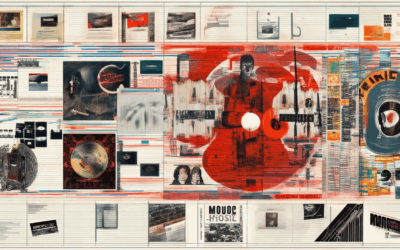The act of crafting the perfect rock lyric is often cited as one of the most challenging yet rewarding aspects of songwriting. For many aspiring musicians, the struggle to convey raw emotion, tell a compelling story, and maintain a powerful rhythm while adhering to the unique demands of rock music can feel overwhelming. However, mastering the art of rock lyrics doesn’t have to remain a mystery. Whether you’re a seasoned songwriter or just beginning your musical journey, understanding the fundamentals of rock songwriting and leveraging proven techniques can empower you to create lyrics that resonate deeply with your audience. From grasping the essential rock song structure to exploring lyrical inspiration and mastering storytelling, this guide will walk you through the key components of crafting rock lyrics that stand out. With the right approach, you’ll learn how to balance depth and simplicity, create an emotional connection, and refine your words to leave a lasting impact.

How To Write A Rock Song
To craft a compelling rock song, follow these steps:1. **Understand the Structure**: Rock songs typically follow a verse-chorus-verse-chorus-bridge-outro format. Variations include omitting the second verse or expanding the bridge for a solo.2. **Verse**: Start with a strong narrative or emotional hook. Focus on storytelling or expressing a mood. Keep the first verse shorter, building momentum.3. **Chorus**: Craft a memorable melody and lyrics that stick. Repeat the chorus to reinforce the song’s theme and catchiness.4. **Bridge**: Introduce a musical shift or lyrical twist. Use this section for a solo or a contrasting idea before returning to the final chorus.5. **Outro**: Conclude with a impactful line or phrase that leaves a lasting impression.6. **Lyrics**: Use vivid imagery and strong metaphors. Experiment with rhyme schemes and word placement to enhance rhythm.7. **Melody and Rhythm**: Play around with chord progressions and tempos. Layer vocals for depth and try effects for character.8. **Collaboration**: Consider co-writing with others to bring fresh perspectives. Listen to rock icons for inspiration and analyze their song structures.9. **Feedback**: Share your work with trusted listeners and refine based on feedback. Iterate until the track feels complete.10. **Final Touches**: Master the recording, ensuring clarity and dynamics. Polish the mix for a professional sound.By following these guidelines, you can create a rock song that resonates with listeners and stands out in the genre.
What is the basic structure of a rock song?
The basic structure of a rock song typically follows a consistent pattern, though variations exist depending on the artist’s style and vision. Here’s a breakdown of the common components:
- Verse : The verses are usually the narrative part of the song, telling a story or expressing emotions. Most rock songs have 1-4 verses.
- Chorus : The chorus is a melodic and lyrical highlight that repeats after each verse, often offering the main theme or hook of the song.
- Bridge : The bridge provides a contrast or shift in the song, often serving as a build-up to the final sections. It can change the tempo, key, or melody.
- Solo : An instrumental solo is common in rock songs, allowing the guitarist or lead vocalist to showcase their skills. This can occur during the bridge or outro.
- Outro : The outro wraps up the song, often summarizing the main themes or providing a final emotional impact. Sometimes it repeats the chorus or solo.
One of the most common structures in modern rock music is the ABABCB pattern, where “A” represents a verse, “B” the chorus, and “C” the bridge. This structure is widely used across various genres, including pop, rock, and hip-hop.
For more insights into songwriting and rock music, visit our Oedipus Band blog, where we explore the creative processes behind iconic tracks and share tips for aspiring musicians.

What Makes a Song a Rock Song?
A rock song is defined by its unique blend of energy, rhythm, and attitude. Here are the key characteristics that set rock music apart:1. **Strong Rhythmic Foundation**: Rock music typically uses a steady 4/4 time signature, with a prominent backbeat provided by the drums and bass. This rhythmic drive supports the verses, choruses, and solos, creating a sense of momentum and excitement.2. **Distinctive Guitar Playing**: Electric guitars are a cornerstone of rock music, often featuring bold riffs, solos, and power chords. The guitar’s role is central, whether it’s driving the melody or providing harmonic support.3. **Powerful Vocals**: Rock singing often emphasizes intensity and projection. Whether it’s a raw, gritty voice or a polished, emotive delivery, the vocals play a crucial role in conveying the song’s energy and message.4. **Driving Beat**: The rhythm section in rock is usually tight and propulsive, with the drums acting as the backbone of the music. This beat keeps the listener engaged and creates a sense of movement.5. **Structured Song Format**: Rock songs follow a standard structure, often including verses, choruses, a bridge, and an outro. This format allows for repetition and variation, making the music both familiar and dynamic.6. **Lyrical Content**: Rock lyrics frequently tackle rebellious themes, personal struggles, or societal issues. They are often direct and impactful, reflecting the artist’s perspective and emotions.7. **Influence from Other Genres**: Rock music draws influences from various genres, including blues, folk, country, and punk. These elements contribute to its diverse sound and rich tapestry of subgenres.8. **Instrumentation**: Common instruments in rock include electric guitars, bass, drums, and sometimes keyboards or horns. The combination of these instruments creates a full-bodied sound that is instantly recognizable.These elements work together to create a unique listening experience, distinguishing a rock song from other genres. To learn more about the evolution and impact of rock music, visit our site and explore our extensive coverage of the genre.
Layout of a Rock Song
A rock song typically follows a standard structure that varies by genre and artist. Below is a breakdown of the common components:
Verse
– The verse is the opening section of the song, introducing the main theme and lyrics. It often repeats in each verse to develop the narrative.
Chorus
– The chorus is the most memorable part of the song, usually repeating the same lines. It emphasizes the central theme and melody.
Pre-Chorus
– This optional section builds tension before the chorus, often featuring a different rhythm or instrumentation.
Bridge
– The bridge provides a change of pace, offering a contrasting musical or lyrical twist. It often leads back into the final chorus.
Outro
– The outro is an optional ending section that may wrap up the song or leave a lasting impression. It can be a reprise of the chorus or a solo.
Introduction
– Some rock songs feature an extended instrumental or vocal intro to set the mood before the verse begins.
Guitar Solo
– In genres like hard rock and heavy metal, a guitar solo is a common feature, often placed after the bridge or in the middle of the song.
Comparison Table
| Rock Genre | Common Sections |
|---|---|
| Hard Rock | Verse, Chorus, Bridge, Solo |
| Heavy Metal | Verse, Chorus, Pre-Chorus, Bridge, Solo |
| Alternative Rock | Verse, Chorus, Bridge, Outro |
Example Songs
– “Stairway to Heaven” by Led Zeppelin: Verse, Chorus, Pre-Chorus, Bridge, Solo, Outro- “Smells Like Teen Spirit” by Nirvana: Verse, Chorus, Bridge, Outro- “Sweet Child O’ Mine” by Guns N’ Roses: Verse, Chorus, Pre-Chorus, Solo
Writing Tips
– Start with a strong verse hook to grab attention.- Use the chorus as the song’s centerpiece.- Experiment with different sections to add variety.- Keep the structure consistent while allowing room for creativity. Learn more about rock music composition.
What Are the 2 Parts of a Rock Song?
A rock song primarily consists of two main structural components: the **verse** and the **chorus**. These two parts work together to create the backbone of the song, providing both storytelling and emotional impact.### 1. VerseThe verse is the narrative portion of the song, where the story unfolds. Typically, verses are repeated throughout the song, with slight variations in structure or lyrical content. Each verse sets the scene, introduces characters, or progresses the plot. The lyrics in the verses often provide context, detail, and character development, making them essential for conveying the song’s theme or message.### 2. ChorusThe chorus serves as the emotional highpoint of the song, often containing the catchiest and most memorable melodies. Unlike the verse, the chorus is usually repeated consistently, making it easily identifiable and singable. The chorus typically summarizes the song’s main idea, reinforces the theme, or provides a powerful emotional climax.These two parts, the verse and the chorus, create a dynamic interplay that defines the structure of many rock songs. The verse provides depth and storytelling, while the chorus delivers the hook that stays with listeners long after the song has ended.
The Formula for Songwriting
Songwriting is a highly individualized art form, and there is no one-size-fits-all formula for success. However, there are common principles and strategies that many successful songwriters use to craft memorable melodies, meaningful lyrics, and compelling arrangements. Below, we explore the essential elements of songwriting and provide actionable insights to help you create your own unique compositions.
1. Inspiration and Source Material
Your songwriting journey begins with inspiration. Sources of inspiration can include:
- Personal experiences and emotions
- Observations of the world around you
- Stories from history or mythology
- Musical styles and genres you admire
Journaling is often recommended as a tool to capture ideas and reflections that may later evolve into songwriting material.
2. Structure
A well-crafted song typically follows a structure that balances variety and coherence. Common song structures include:
- Verse-Chorus-Bridge-Chorus-Outro
- Verse-Prelude-Chorus-Bridge-Outro
- Ballad structure (AABA)
- Alternative structures like ABAB or ABCB
Each section serves a purpose, contributing to the overall narrative and emotional impact of the song.
3. Lyrical Content
Lyrics are the heart of a song, conveying its meaning and emotion. Effective lyrics often:
- Tell a story or paint a vivid image
- Express universal themes or emotions
- Use metaphors and similes to enhance imagery
- Reflect the songwriter’s unique perspective
Consider focusing on specific themes like love, loss, identity, or adventure to give your lyrics direction.
4. Melody and Rhythm
A great melody is the backbone of a song, and rhythm provides the foundation upon which notes are built. Considerations include:
- Choosing a scale or mode that suits your composition
- Creating a memorable hook or chorus
- Using dynamics and tempo changes to add contrast
- Ensuring vocal delivery enhances the emotional intent
Experiment with different musical styles and techniques to find your unique sound.
5. Arrangement and Production
Once your song is written, the arrangement and production phase fine-tune its impact. Key considerations include:
- Balancing acoustic and electric elements
- Using backing tracks to enhance texture
- Applying effects and processing creatively
- Editing for consistency and flow
Collaboration with producers or co-writers can also lead to fresh perspectives and innovations.
Conclusion
Songwriting is a lifelong journey of discovery and growth. By embracing your unique perspective and continuously exploring new techniques, you can create music that resonates deeply with your audience. Start today, and let your creativity flow!



0 Comments